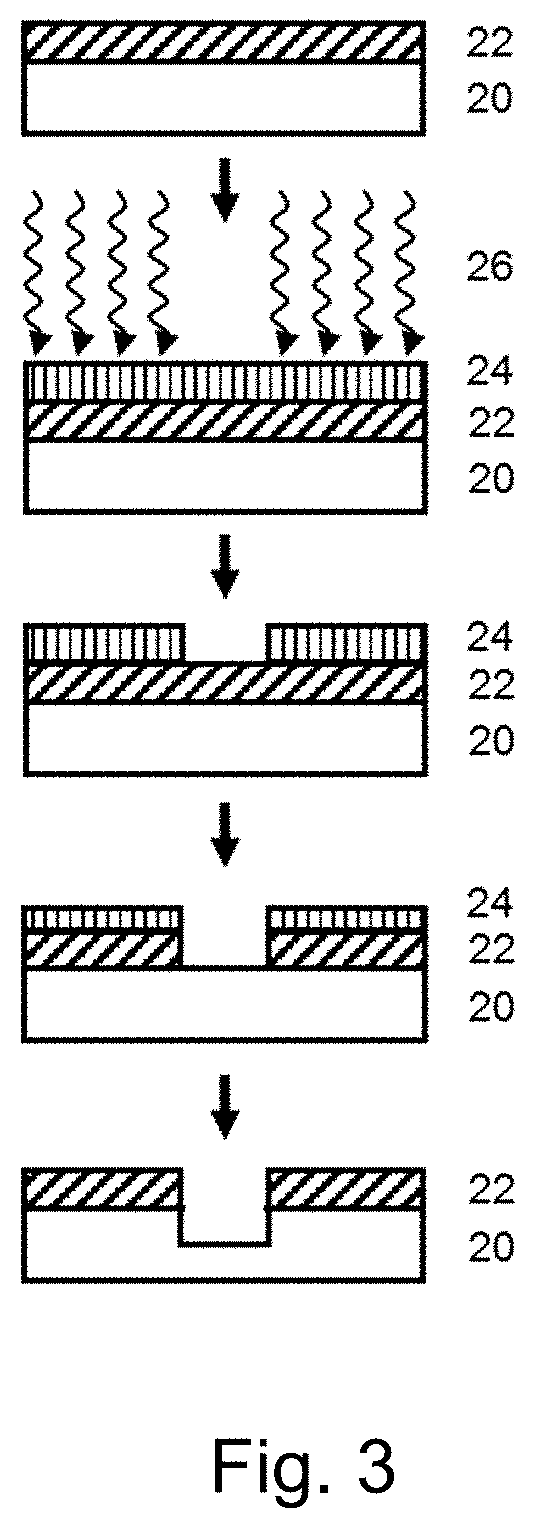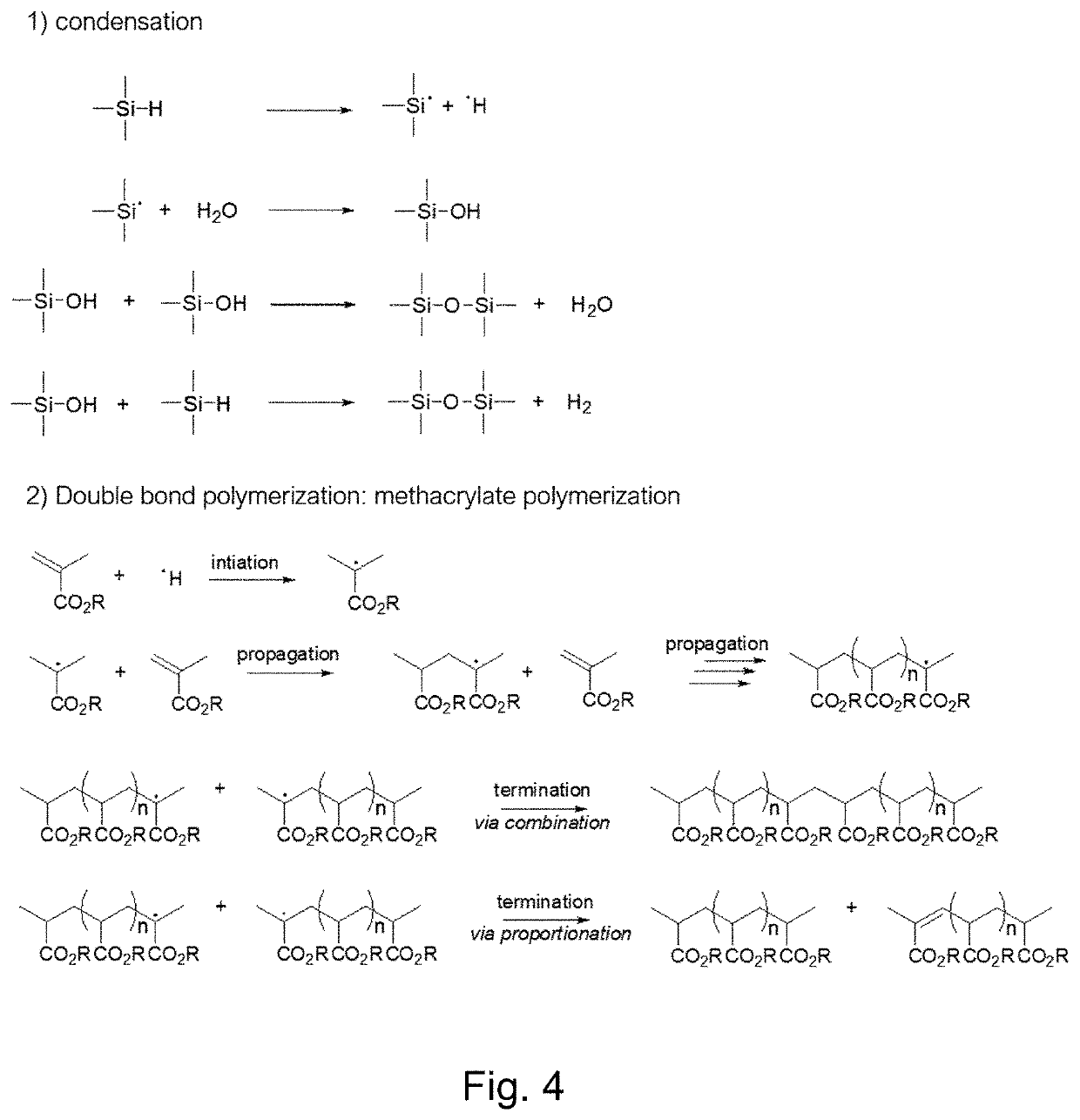Functional hydrogen silsesquioxane resins and the use thereof
a hydrogen silsesquioxane and resin technology, applied in the field of radiation-based, can solve the problems of poor ler, large disadvantage, car materials, etc., and achieve the effects of reducing the number of lithographic stacks
- Summary
- Abstract
- Description
- Claims
- Application Information
AI Technical Summary
Benefits of technology
Problems solved by technology
Method used
Image
Examples
embodiments
[0055]Unless otherwise stated herein or clear from the context, any percentages referred to herein are expressed as percent by weight based on a total weight of the respective composition.
[0056]Unless otherwise stated, properties that have been experimentally measured or determined herein have been measured or determined at room temperature. Unless otherwise indicated, room temperature is 25° C.
[0057]It must also be noted that, as used in the specification and the appended claims, the singular forms “a,”“an” and “the” include plural referents unless otherwise specified.
[0058]As used herein, the term “about” refers to a value which is ±5% of the stated value. As used herein, the term “about” refers to the actual given value, and also to an approximation to such given value that would reasonably be inferred to one of ordinary skill in the art, including approximations due to the experimental and / or measurement conditions for such given value.
[0059]Unless otherwise stated, the term “mo...
example 1
[0173]Preparation of polymer solution with HTEOS:MAPTMOS=97.5:2.5 molar ratio
[0174]In one flask a mixture of 100 grams of triethoxysilane (HTEOS) and 3.88 grams of 3-methacryloxypropyltrimethoxysilane (MAPTMOS) monomers, was dissolved in 193.02 grams of methyl tetrahydrofurfurylether (MeOTHF). The HTEOS:MAPTMOS molar ratio is 97.5:2.5. A mixture of 48.26 grams of MeOTHF, 21.55 grams of deionized water (DIW) and 9.88 grams of 0.01 M nitric acid was mixed and added to the above monomers' solution into three equal portions in 1.5 hours. After the completion of addition, the reaction was continued to mix for another 17 hours. Evaporation was carried out to obtain 15-25% of solid content. Methyl ethyl ketone (MEK) was added four times to the polymer weight. The obtained polymer solution was filtered with 0.2-micron filter. Gel permeation chromatography data shows Mw of 3945, Mn of 2047, and polydispersity of 1.93.
example 2
[0175]Preparation of polymer solution with HTEOS:MAPTMOS=95:5 molar ratio
[0176]In one flask a mixture of 100 grams of triethoxysilane (HTEOS) and 7.96 grams of 3-methacryloxypropyltrimethoxysilane (MAPTMOS) monomers, was dissolved in 193.02 grams of methyl tetrahydrofurfurylether (MeOTHF). The HTEOS:MAPTMOS molar ratio is 95:5. A mixture of 48.28 grams of MeOTHF, 22.12 grams of deionized water (DIW) and 10.14 grams of 0.01 M nitric acid was mixed and added to the above monomers' solution into three equal portions in 1.5 hours. After the completion of addition, the reaction was continued to mix for another 17 hours. Evaporation was carried out to obtain 15-25% of solid content. Methyl ethyl ketone (MEK) was added four times to the polymer weight. The obtained polymer solution was filtered with 0.2-micron filter. Gel permeation chromatography data shows Mw of 3052, Mn of 1690, and polydispersity of 1.81.
PUM
| Property | Measurement | Unit |
|---|---|---|
| thickness | aaaaa | aaaaa |
| temperature | aaaaa | aaaaa |
| wavelength | aaaaa | aaaaa |
Abstract
Description
Claims
Application Information
 Login to View More
Login to View More - R&D
- Intellectual Property
- Life Sciences
- Materials
- Tech Scout
- Unparalleled Data Quality
- Higher Quality Content
- 60% Fewer Hallucinations
Browse by: Latest US Patents, China's latest patents, Technical Efficacy Thesaurus, Application Domain, Technology Topic, Popular Technical Reports.
© 2025 PatSnap. All rights reserved.Legal|Privacy policy|Modern Slavery Act Transparency Statement|Sitemap|About US| Contact US: help@patsnap.com



